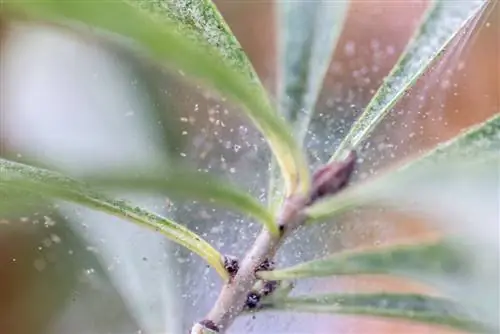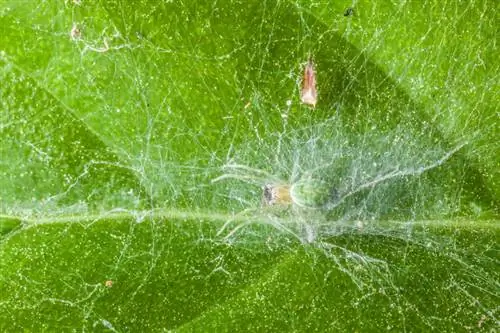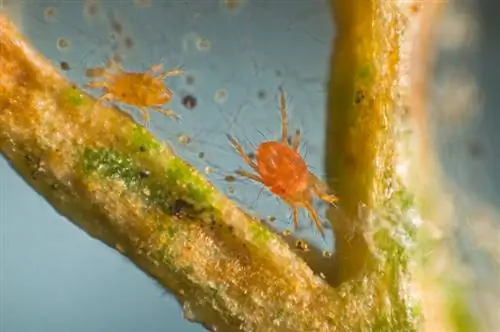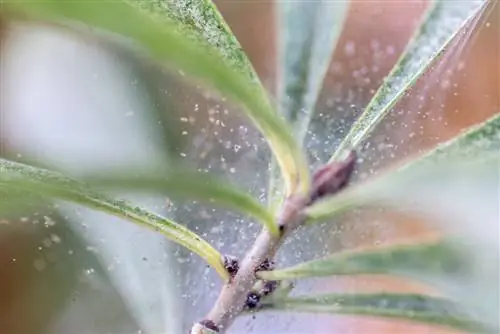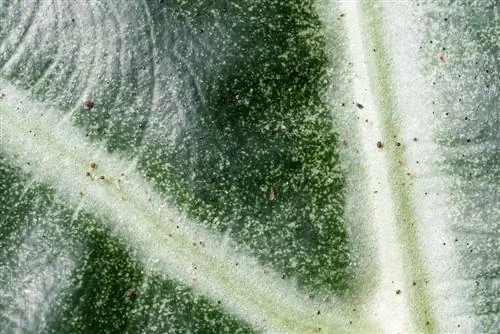- Author admin [email protected].
- Public 2023-12-16 16:46.
- Last modified 2025-01-23 11:19.
Spider mites are one of the annoying pests that every plant lover has to deal with. They appear seemingly out of nowhere and spread en masse within a short period of time. There is great despair when the mites appear again after successful control.
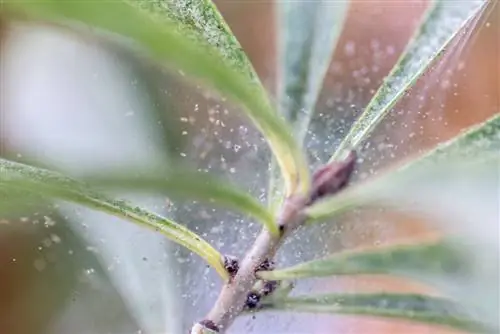
What can you do against spider mites?
The first countermeasure for spider mites is to shower the affected leaves in the shower or bathtub. Treat the leaves with a tobacco decoction, tea, herbal extracts and manure, rapeseed oil and neem oil or soapy water. In the event of extreme spread, chemical agents are resorted to.
What helps against spider mites
Spider mites are annoying pests that occur again and again on some houseplants or in the greenhouse. Especially when it comes to crops, it is important to naturally combat plant sap suckers. Sprays leave behind residues that can get into food. Houseplants should only be combated with drastic measures if there is a severe infestation.

Housing the plants can help with a slight infestation
First aid for spider mites:
- Rush the plant thoroughly in the shower
- Remove eggs with a damp cloth
- Put a transparent plastic bag over the plant
- Tie the bag over the ball of earth
- Leave the plant like this for the next two weeks
This method improves the microclimate between the leaves. The humidity increases significantly, so that the spider mites die off over time. However, eggs that have already been laid can survive this procedure, so you will have to check the plant for a relapse in the near future. Do not place the plant on a south-facing windowsill, but rather choose a shady location. In the sun, the temperature under the plastic bag can become very hot, causing damage to the leaves.
Beneficial insects against spider mites
Many beneficial insects can be used specifically to combat sucking pests. These insects can be used to combat spider mites biologically, which means that spraying can be almost completely eliminated in fruit growing. In the greenhouse or on house plants, you can use predatory mites against spider mites if adjusting the temperature and humidity has not been successful.
| Art | Temperature | Humidity | |
|---|---|---|---|
| Phytoseiulus persimilis | Predatory mite | 17 to 28 degrees Celsius | at least 60 percent |
| Amblyseius californicus | Predatory mite | at least 23 degrees Celsius | not less than 60 percent |
| Feltiella acarisuga | Gall midge | 20 to 26 degrees Celsius | 60 percent is optimal |
Take pruning measures
If perennials such as hemp or shrubs and trees are heavily infested with spider mites, pruning measures are recommended. With hemp, remove individual leaves to stop the pests from spreading further. If the oleander is infected with spider mites, consistent pruning of the affected leaves helps. If there is a severe infestation, the poplar fig can be cut back to the stump. It then sprouts again.
Get rid of spider mites with home remedies
The list of home remedies for spider mites is long and ranges from milk and horsetail broth to dishwashing liquid and vinegar. There is no best way to get rid of pests in one fell swoop. Each remedy has its advantages and disadvantages and sprays must be used over a longer period of time for lasting success.
Nicotine
A tobacco decoction is a proven means of killing pests, as nicotine is a strong neurotoxin. This is precisely why you should under no circumstances use nicotine to combat pests. Parts of the poison are absorbed by the plant and - if it is a cultivated plant - end up on your table. In the 1970s, the use of nicotine to combat pests on plants in agriculture was banned.
Broths, teas and manures
When making brews, teas and manures, you can use a rule of thumb: for every ten liters of water there are one kilogram of fresh herbs or 200 grams of dried herbs. While manures are prepared with cold water and fermented over several days, brews and teas are prepared with boiling water.
Lukewarm water is suitable for broths as the herbs steep for 24 hours. The approaches are diluted with water in a ratio of 1:10 before watering. If you use the products for spraying, a dilution of 1:20 to 1:50 is recommended.
- Tea for spritzing: wormwood and tansy leaves, lavender branches
- Brew for watering: worm fern and bracken
- Broth for pouring: onions and garlic
Rapeseed oil and neem oil

Neem oil and rapeseed oil are effective helpers in the fight against spider mites
Neem tree oil contains azadirachtin, which stops spider mites from laying eggs. Since the active ingredient does not have a selective effect and also harms beneficial insects, you should not use neem oil when using predatory mites. An aqueous solution with rapeseed oil is gentler. When sprayed on the leaves, it forms an oily film under which the spider mites are trapped. They can no longer breathe and die.
Soap suds
A self-made agent consisting of 15 milliliters of potassium soap and spirit in one liter of water is ideal for spraying in the early stages when the infestation is not yet very advanced. Be sure to spray directly on the colonies on the undersides of the leaves. The measure must be repeated every four to five days. Dishwashing liquid is suitable to a limited extent as it is usually not biodegradable.
There are numerous home remedies for spider mites. The most effective solutions are oil or soap.
Chemical remedies against spider mites
Before you use chemicals, you should weigh the benefits against possible harm. In most cases, chemical controls do more harm to the plants than they eliminate the spider mite case. You achieve the greatest possible success when most of the animals have already hatched from their winter eggs and this first generation of mites has not yet laid any summer eggs.
Biological alternative to chemistry
If the infestation is still limited, you can use sprays based on rapeseed oil with added pyrethrins. Such biological agents do not act selectively, but kill spider mites as well as beneficial insects. Since not all pests are often detected during the first spraying, the treatment must be repeated at regular intervals. Spray the undersides of the leaves generously so that the pests come into direct contact with the poison.
When pesticides make sense
Plants that generally require a location on the windowsill and cannot be cultivated on the balcony or terrace should be treated with a pesticide if they are infested with spider mites. This also applies to stubborn pest infestations or large populations. The products are often used against spider mites on orchids. Even the undemanding cactus or the heat-loving palm tree can be freed from spider mites using sprays.
Acaricides are preferred against spider mites. They are effective against various arachnids and may only be used on ornamental plants. They contain around 15 different active ingredients, some of which are based on sulfur and tin compounds.
Interesting facts and tips:
- some acaricides are also effective against biting insects and house dust mites
- not harmful to wild bees, butterflies and bumblebees
- optimal effect when sprayed directly on spider mite colonies
Preventing an Infestation
When you transport potted plants to their winter quarters in autumn, you should carefully check the undersides of the leaves for spider mite infestation. If the leaves are already colonized, the pests can multiply rapidly over the next few weeks. To prevent this from happening, you should make the living conditions for the mites suboptimal.

Constant spider mites: find out the cause
The arachnids need warm and dry weather to develop. Wet conditions and cool temperatures severely limit populations. The pests find ideal conditions at temperatures around 30 degrees Celsius and dry air. Under these conditions, the development time of the mites is greatly reduced, meaning they can develop large populations within a very short space of time.
Houseplants are often attacked by spider mites in winter if they are placed on the windowsill directly above the radiator. Even weakened plants are a target for pests, because the plant tissue is particularly easy to pierce and suck out.
What to do to permanently get rid of spider mites?
If you want to get rid of spider mites permanently, you must identify and eliminate the causes of the infestation. If your houseplants on the windowsill are attacked in winter, changing their location can help. If the air in the room is very dry overall, you should place a small bowl of water on the heater. You can also moisten a towel and place it over the radiator.
No spider mites in the greenhouse
A natural measure against spider mites in the greenhouse is the right mix of plants. Monocultures are generally more susceptible to pests than mixed cultures. They can reproduce more quickly in a one-sided plant population. Mix vegetables with herbs and make sure that the plants do not belong to the same family. Sufficient space between the plants ensures optimal growth and supports vitality.
No chance of survival in the greenhouse:
- Conditions: pay attention to uniformity and ventilate regularly
- Temperature: Avoid increases by protecting the greenhouse from the blazing midday sun
- Humidity: large-leaved plants prevent severe waste
When measures don't help
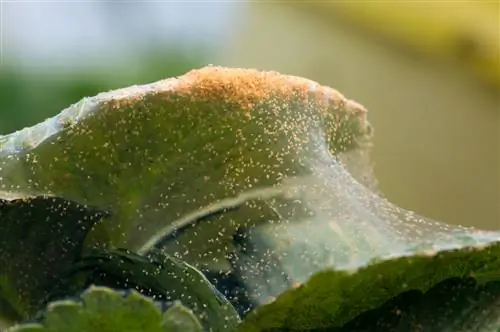
If the infestation cannot be controlled with the best will in the world, it may be because the cause has not been eliminated
Experience reports show again and again that all measures to combat it have no effect. If this is the case, it is likely that the correct cause of the spider mite infestation has not been identified. In some cases, the pests can multiply despite increased humidity and moderate temperatures. Despite their small size, spider mites prove to be extremely resilient.
Beneficial insects are ineffective
Predatory mites are efficient pest controllers, but they require different conditions for their development than spider mites. They rely on a humidity of at least 60 percent. If the spider mite infestation does not subside despite the use of predatory mites, the beneficial insects have probably died due to the suboptimal living conditions.
No improvement despite high humidity
If measures have been taken to improve the indoor air and the temperature has been reduced, but the plants are still plagued by spider mites, the he alth of the plant may be weakened. Spider mites can survive well despite adverse living conditions if they can easily get the coveted plant sap.
If the ornamental plants grow in the same substrate for several years, the nutrients may be used up and deficiency symptoms may occur. Weakened plants are repeatedly attacked. Replant the affected plants and provide them with fresh soil. Herbal decoctions support vitality and strengthen the plant.
| Effect | Preparation | Suitability | |
|---|---|---|---|
| Comfrey | supplies potassium, silica and tannins | Pour hot water over the leaves and let them steep | undiluted for watering |
| Stinging Nettle | strengthens the plant tissue | Pour warm water over the leaves and let them ferment | 1:20 for watering and 1:50 for spraying |
| Field horsetail | Silicic acid to strengthen cell walls | Soak plants in water for 24 hours and then simmer for 30 minutes | 1:20 for spraying |
| Yarrow | prevents sucking pests | Pour cold water over the herbs and let them steep for 24 hours | undiluted for spraying |
Identifying spider mites
Spider mites are a suborder and belong to about 1.200 species of mites. They live on the underside of leaves on different plants and form fine webs to protect themselves. Their diet consists exclusively of the sap of plants. To do this, they pierce the epidermis with their mouthparts and suck up the liquid. Some species are more common on certain plants:
- Schizotetranychus celarius occurs on bamboo
- Panonychus ulmi is considered a fruit tree spider mite
- Bryobia kissophylla specializes in ivy
- Brevipalpus californicus refers to the orchid spider mite
Their color varies depending on the color of the plant juices absorbed and can range from yellowish to greenish to orange. Small red spider mites are typical of houseplants. White spider mites are still in the larval stage.
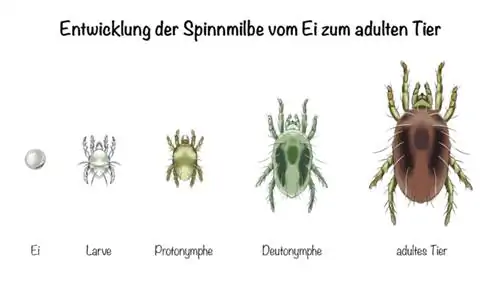
Common spider mite (Tetranychus urticae)
This species is characterized by a translucent body that is light to brown-green in color. The two blurred spots on both sides are noticeable. Females hibernate and can survive temperatures down to -15 degrees Celsius. During the winter they are colored orange-red. In Germany, the common spider mite attacks around 90 cultivated and ornamental plants, including frangipani, beans and wine, potatoes and sunflowers or fruit trees and fruit shrubs.
Red spider (Panonychus ulmi)
If you find red spider mites on fruit bushes, it is usually the red spider. It is also known as the fruit tree spider mite because of its preferred food spectrum and is found on apples and pears, gooseberries and currants or grape vines. It can also affect houseplants such as calathea. Females are half a millimeter long and are brick red in color. The white bristles on the back are characteristic. This species usually overwinters in the egg stage on fruit trees.
Excursus
Cobwebs
Spider mites owe their German name to their ability to produce spider threads. However, not all species in this suborder have this ability. Only the representatives of the subfamily Tetranychinae have a large gland. This produces a secretion, which is spun into a double thread with two hollow bristles. Orchid and cactus spider mites do not produce webs.
Form webs:
- Common spider mites
- Linden and hawthorn spider mites
- Fruit tree spider mites
Commonly affected plants
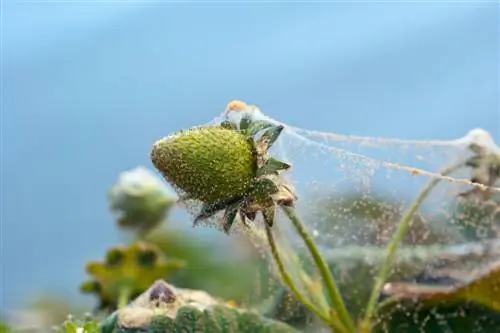
Spider mites affect both cultivated and ornamental plants
Spider mites are not picky about their food plants. They attack a wide variety of plants from different families such as hibiscus, Hawaiian palm or Dipladenia. However, there are some plants whose living conditions ideally suit the needs of pests. Weakened plants that do not normally fall into the usual prey pattern can also be attacked.
What helps against common spider mites:
- Fight boxwood spider mites with potash soap solution
- Treat spider mites on ivy with an aqueous tea tree oil solution
- Get rid of spider mites on hemp first by cutting off the leaves, then inject essential oils
- Strengthen bonsai with rock dust and prevent spider mite infestation with onion broth
Banana plant
The large leaves of the Musa are sought after by spider mites. After successful control, the sucking pests reappear. To keep the plant pest-free, you should treat the leaves with a suitable spray at least three times a day. You shouldn't forget the rolled edges at the tip of the leaf, because spider mites stay here unnoticed.
Make spray:
- Pour 500 milliliters of distilled water into a container
- Dissolve 2.5 grams of potassium soap in it
- Add 2.5 grams of denatured alcohol
Avoid cold irrigation water and fertilizer during treatment. Algan can be administered as a growth aid to weakened plants. It is an organic source of potassium that supports the construction of cell walls. In order for the banana plant to recover quickly, you should cut off the lowest leaves. Make sure to cut horizontally to reduce juice leakage.
Roses and cucumbers

Too much nitrogen attracts spider mites to roses and cucumbers
In the warm summer months, long dry periods occur more often, during which spider mites also find optimal living conditions. They colonize outdoor and cold frame cucumbers equally and don't stop at rose bushes. Spider mites on cucumbers and roses are often due to too high a nitrogen content.
Pay particular attention to moist air by regularly watering the substrate in the immediate area. Dusting the leaves with ground sulfur has proven to be a preventive measure. This method frees roses from spider mites and at the same time protects against mildew. Sulfur is harmless to bees, but harms beneficial insects such as predatory mites and ladybirds.
Tip
Sulfur also helps against pest infestations that have already spread. Pollinate the plants at temperatures above 20 degrees Celsius and repeat the procedure after rainfall.
Fruit trees and fruit bushes
The fruit tree spider mite is a feared pest in orchards and private gardens. Not only is the apple tree affected, but the lemon tree is also often home to spider mites. Strong trees can tolerate an infestation of 40 percent. If the infestation continues to increase, you should combat the pest.
When it comes to crops, avoid chemical acaricides. As soon as you observe the pest on the undersides of the leaves, start with an oil treatment in warm weather. Spray the undersides of leaves with a neem oil preparation and moisten shrubs and trees with water.
This helps preventatively:
- Mulching tree slices
- fertilize little, an annual compost addition is sufficient
- water regularly
Hydrangeas and oleanders
Spider mites on hydrangeas are a problem when cultivated outdoors when the climate is dry and warm. The pests prefer high temperatures and low humidity just like the oleander. An airy location with plenty of ventilation drastically reduces spider mites. If the infestation is advanced, you can use a rapeseed oil-based spray and spray the plants until they are dripping wet. Sprays with pyrethrins or abamectin are suitable for ornamental plants. Carry out this action on a cloudy day or in the evening.
Tip
To prevent spider mites from spreading among ornamental plants, you should clear the garden of French weed. This is often first attacked by the pests, which then spread to ornamental and useful plants.
Frequently asked questions
How do I get rid of spider mites?
First, you should spray visible colonies with a hard jet of water. Then wipe the eggs with a damp cloth. Since the pests like to hide under rolled leaf edges or in leaf axils, spray the entire plant with an aqueous solution of neem or rapeseed oil. Treatment with a spray made from potash soap and spirit is also effective.
Do spider mites overwinter in the greenhouse?

Spider mites survive even harsh winters
Common spider mites overwinter in the form of red winter females. They form dense colonies in protected hiding places such as piles of leaves, holes in the ground or under bark scales. If the pests have spread in the greenhouse, they can also overwinter there in niches and cracks. Temperatures of -15 degrees Celsius do not harm the common spider mite. In contrast, the fruit tree spider mite usually overwinters in the egg stage on the bark of infected trees.
Are spider mites dangerous for people?
From a medical point of view, spider mites are not dangerous to humans. Their mouthparts are unable to penetrate the skin. They can quickly develop into annoying tenants that can get on your last nerve to fight. If spider mites have developed into a nuisance, often only drastic measures such as radical pruning or the use of pesticides can help.
What damage do spider mites leave behind on plants?
Spider mites prefer to live on the underside of leaves near the leaf veins. A single insect can pierce the epidermis of the cells and suck out the juice more than 20 times per minute. Yellow spots first form, giving the leaf a mottled appearance. If the infestation is severe, the leaves turn completely brown and wilt. Webs are the first sign of a spider mite infestation.
Exceptions that do not form webs:
- some greenhouse spider mites
- Orchid spider mites
- Cactus spider mites
What life cycle do spider mites go through?
The common spider mite develops into an adult through four stages of development. A transparent and white-appearing larva hatches from the egg, which is usually located on the underside of the leaf. This first develops into a protonymph and finally into a deutonymph before transforming into an adult mite.
In the larval and nymph stages there are active periods that alternate with long periods of rest. Adult spider mites are colored light yellow, orange, light or dark green depending on the food they eat. They can appear red, brown or almost black and have two dark spots.

